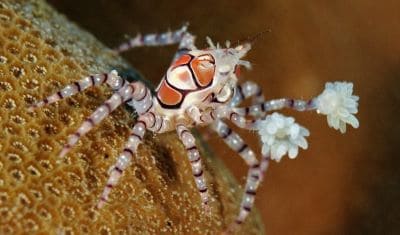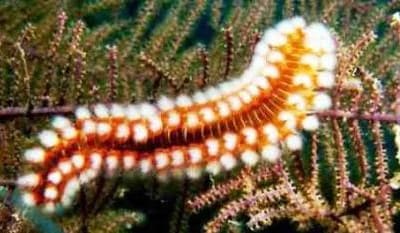Home › Sea Life › Animals › Invertebrates › Crustacean › Crabs
Interesting Facts about Sea Crabs
[Crab Phylum: Arthropoda] [Class: Malacostraca] [Order: Decapoda] [Subphylum: Crustacean]
There are more than seven thousand (7,000) different species of crabs, and most of them are members of a select group known as decapod crustaceans.
Humans eat tonnes of seafood animals, especially the savoury blue crab. Even so, this section contains information about invertebrate sea crabs that scuba divers encounter in the seas and oceans.
Where Do Crustacean Crabs Species Live?
By and large, you can find crabs living in all of the oceans and many of the freshwater ecosystems.
Often, you find them living inside burrows in mud or sand, especially at high tide and during the wintertime.
Scuba divers see most of the decapod crustaceans in the benthic zones of the major tropical regions.
The terrestrial crab species lives exclusively on land, often in areas that are far away from any major body of water.
Yet, some species of crab can actually survive on land and in water. So, they need to keep their gills moist while on terra firma. For this reason, you usually find them residing close to the coastline.
Crab Characteristics and Behaviour
Like most animals of the subphylum Crustacea, the majority of crabs have a thick exoskeleton made of chitin, used for protection. They also have a single pair of hinged, pincer-like claws (called chelae) that they use during feeding and whenever they feel threatened.
In fact, crabs have five (5) pairs of legs (same as its close relatives - lobsters). The large pinching claws located at the front are their defencive appendages. Whereas, the broad and flatter pair of legs at the back serve as paddles.
Yes... sea crabs can swim!
These stubby sea creatures have a flat, broad belly and a tail that tends to curl under its midsection. They use gills to breathe, even though the gills of land crabs perform more like lungs.
To say that crabs vary in size is an understatement. For example, the tiny pea crab (Pinnotheres pisum) measures no more than 2.5 centimetres across (less than an inch). Whereas, the Japanese spider crab is a giant, measuring thirty (30) centimetres across and four (4) metres (12 feet) from tip to tip when its legs are stretched.
The two large eyes that extend from a crab's head have movable stalks, fixed above two pairs of antennas. But, its mouthparts (e.g. three pairs of appendages) are situated underneath its head.
Fun Fact: The hermit species, anomuran decapod crustaceans, have developed a habit of occupying empty snail or mollusk shells for shelter. It's also common for them to scavenge around for a bigger shell when they have outgrown it.
Different Kinds of Crab Species
You can read more in other sections about the most common crab species seen while scuba diving or snorkeling, including:
 Chesapeake Blue Crab (Callinectes sapidus)
Chesapeake Blue Crab (Callinectes sapidus)- Boxer crab (Lybia tessellata)
- Coconut crab (Birgus latro)
- European spider crab (Maja squinado)
- Fiddler crab
- Hermit crabs (Paguroidea)
- Horseshoe crabs (Limulidae)
- Porcelain crabs (Porcellanidae)
- Zebra crabs (Zebrida)
In general, we can separate the crab animal species into two types of crabs, true crab scientific name Brachyura, and Anomura (the fake crabs).
The main difference is the short abdomen and four pairs of 'walking' legs in true crabs. Whereas, a false crab will have a bigger abdomen and a fewer number of legs used for mobility.
Other Types of Crab
Arrow Crab (Stenorhynchus seticornis)
It has a number of common names, including yellowline arrow crab. It is a distinctive decapod crustacean commonly found in western parts of the Atlantic Ocean, especially North Carolina, Bermuda, the Caribbean Sea, and Brazil.
Arrow crabs thrive best around shallow coral reef formations, rock and rubble zones, and sponges, typically between three (3) and ten (10) metres deep.
Description and Size
Stenorhynchus seticornis are mostly orange, yellow, or reddish brown and they have violet coloured claws.
Their eyes protrude on stalks, and their pointed arrow-like rostrum, with its serrated edges, is seen as the main signature feature.
Like many crab types, they have long spindly legs and a pointed head that creates the general appearance of a tiny underwater spider crossed with a spear (hence their scientific nicknames 'arrow crabs').
These marine crabs have a triangular carapace that measures about three (3) centimetres, with extremely long spider-like legs that can grow to ten (10) centimetres in length.
Behaviour and Reproduction
Most species of crabs are nocturnal scavengers, and the arrow crab spends much of the day time hidden in rocky crevices, among the spines of sea urchins, underneath sea anemones, or sheltering in the branches of Acropora corals.
They feed most on algae, detritus, and small segmented worms, such as bristle worms and feather duster worms.
They may also become 'symbiotic cleaners' and eat parasites and pests from other sea creatures and fish, such as moray eels.
Here's the thing:
This is the main reason why aquarists consider arrow crabs as being reef safe, even though they can act quite aggressively toward their own species and prey on tiny ornamental invertebrates.
When male and female arrow crabs mate, she will carry the eggs underneath her abdomen until they are ready to hatch. The larvae are buoyant and feed on planktonic organisms as they float near the surface.
They will eventually settle on the ocean floor and begin shedding their hard exoskeleton (outer shell) and they grow and develop into adulthood.
Box Crabs (Calappa)
Caribbean King Crab (Maguimithrax spinosissimus)
Fairy Crab (Lauriea siagiani)
Guard Crabs (Trapezia)
Coral Guard Crab
Rust-spotted Guard Crab (Trapezia rufopunctata)
Harlequin Swimming Crab (Lissocarcinus orbicularis)
Hermit Crabs (Paguroidea)
There are more than 1,000 recognised hermit crab species belonging to the superfamily Paguroidea, which contains marine hermit crabs (Paguridae) and land hermit crabs (Coenobitidae).
Check out some fun and interesting facts about hermit crabs, including where they live, what they eat, and how anomuran decapod crustaceans reproduce.
Horned Ghost Crab (Ocypode ceratophthalmus)
King Crab
Orangutan Crab (Achaeus japonicus)
Pea Crab (Pinnotheres pisum)
Porcelain Crabs (Porcellanidae)
Broad-clawed Porcelain Crab (Porcellana platycheles)
Green Porcelain Crab (Petrolisthes armatus)
Porcellanella brevidentata (new species)
Red King Crab (Paralithodes camtschaticus)
Red Rock Crab (Guinusia chabrus)
Spider Crabs (Majoidea)
Great Spider Crab (Hyas araneus)
Japanese Spider Crab (Macrocheira kaempferi)
Northern Kelp Crab (Pugettia producta)
Portly Spider Crab (Libinia emarginata)
Spiny Rock Crab (Thalamita crenata)
Sponge Crab (Dromia personata)
Spotted Reef Crab (Carpilius maculatus)
Swimming Crabs (Portunidae)
Urchin Crab (Dorippe frascone)
Velvet Swimming Crab (Necora puber)
Zebra Crabs (Zebrida)
Zebrida brevicarinata
Zebrida longispina
Zebra Urchin Crab (Zebrida adamsii)
What Do Sea Crabs Eat?
Most crabs are omnivorous scavengers. In other words, besides eating vegetable matter, other crabs, and small fishes (alive, dead, or decaying), they will also feed on.
- Algae (e.g. planktonic organisms)
 Clams
Clams- Eggshell
- Mollusks
- Shrimp
- Snails
- Squid
- Worms (especially cinder worms)
Crab Reproduction
Most crabs display sexual dimorphism. As a result, it's quite easy to differentiate males (with larger claws) from females. In fact, males use enlarged chela for communication and to attract a mating partner.
In addition, the abdomen of crustaceans (the pleon) tends to be narrower and more of a triangular shape in male crabs. Whereas, female crabs tend to have a broad, somewhat rounded abdomen. This is the area where they will eventually brood fertilised eggs.
Here's the thing:
When female crabs lay their eggs, including land crabs, they need to do it in water. Thus, she will carry the eggs on her body, inside the abdominal sac, until they hatch.
Some baby crabs hatch and look like small adults straight away - but not all. Instead, most newly hatched crabs (zoea) tend to be tiny, transparent creatures absent of any fully formed legs drifting around at the upper column of the water.
They will shed their exterior covering several times, through a process called metamorphosis, before they develop into the adult form.
Fun Fact: A fading moon is the signal for female crabs to enter the ocean and start laying (up to 100,000 eggs at a time). Yet, the blue crab is capable of carrying up to two (2) million eggs in the brooding season.
Related Information and Help Guides
- Fun Facts about Boxer Crabs (Lybia tessellata)
- Sea Shrimp Facts and Species Information with Examples
- Camel Shrimp Fun Facts and Information with Pictures
- Ecological Role of Copepods and Krill in Marine Environments
Note: The short video [4:05 minutes] presented by 'HappyFriday' contains even more fun facts about crabs and several other invertebrate crustaceans.